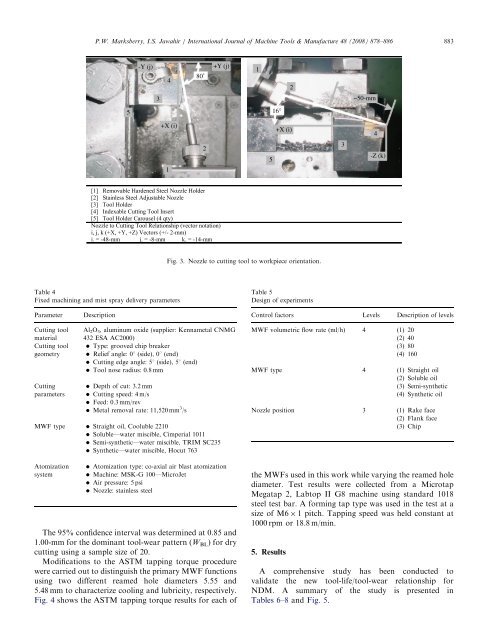A comprehensive tool-wear/tool-life performance model in the ...
A comprehensive tool-wear/tool-life performance model in the ...
A comprehensive tool-wear/tool-life performance model in the ...
You also want an ePaper? Increase the reach of your titles
YUMPU automatically turns print PDFs into web optimized ePapers that Google loves.
ARTICLE IN PRESS<br />
P.W. Marksberry, I.S. Jawahir / International Journal of Mach<strong>in</strong>e Tools & Manufacture 48 (2008) 878–886 883<br />
-Y (j)<br />
4<br />
80˚<br />
+Y (j)<br />
1<br />
2<br />
3<br />
~50-mm<br />
5<br />
16°<br />
+X (i)<br />
+X (i)<br />
4<br />
1<br />
2<br />
5<br />
3<br />
-Z (k)<br />
[1] Removable Hardened Steel Nozzle Holder<br />
[2] Sta<strong>in</strong>less Steel Adjustable Nozzle<br />
[3] Tool Holder<br />
[4] Indexable Cutt<strong>in</strong>g Tool Insert<br />
[5] Tool Holder Carousel (4 qty)<br />
Nozzle to Cutt<strong>in</strong>g Tool Relationship (vector notation)<br />
i, j, k (+X, +Y, +Z) Vectors (+/- 2-mm)<br />
i. = -48-mm j. = -8-mm k. = -14-mm<br />
Fig. 3. Nozzle to cutt<strong>in</strong>g <strong>tool</strong> to workpiece orientation.<br />
Table 4<br />
Fixed mach<strong>in</strong><strong>in</strong>g and mist spray delivery parameters<br />
Table 5<br />
Design of experiments<br />
Parameter<br />
Description<br />
Control factors Levels Description of levels<br />
Cutt<strong>in</strong>g <strong>tool</strong><br />
material<br />
Cutt<strong>in</strong>g <strong>tool</strong><br />
geometry<br />
Cutt<strong>in</strong>g<br />
parameters<br />
Al 2 O 3 , alum<strong>in</strong>um oxide (supplier: Kennametal CNMG<br />
432 ESA AC2000)<br />
Type: grooved chip breaker<br />
Relief angle: 01 (side), 01 (end)<br />
Cutt<strong>in</strong>g edge angle: 51 (side), 51 (end)<br />
Tool nose radius: 0.8 mm<br />
Depth of cut: 3.2 mm<br />
Cutt<strong>in</strong>g speed: 4 m/s<br />
Feed: 0.3 mm/rev<br />
Metal removal rate: 11,520 mm 3 /s<br />
MWF type Straight oil, Cooluble 2210<br />
Soluble—water miscible, Cimperial 1011<br />
Semi-syn<strong>the</strong>tic—water miscible, TRIM SC235<br />
Syn<strong>the</strong>tic—water miscible, Hocut 763<br />
Atomization<br />
system<br />
Atomization type: co-axial air blast atomization<br />
Mach<strong>in</strong>e: MSK-G 100—MicroJet<br />
Air pressure: 5 psi<br />
Nozzle: sta<strong>in</strong>less steel<br />
The 95% confidence <strong>in</strong>terval was determ<strong>in</strong>ed at 0.85 and<br />
1.00-mm for <strong>the</strong> dom<strong>in</strong>ant <strong>tool</strong>-<strong>wear</strong> pattern (W BL ) for dry<br />
cutt<strong>in</strong>g us<strong>in</strong>g a sample size of 20.<br />
Modifications to <strong>the</strong> ASTM tapp<strong>in</strong>g torque procedure<br />
were carried out to dist<strong>in</strong>guish <strong>the</strong> primary MWF functions<br />
us<strong>in</strong>g two different reamed hole diameters 5.55 and<br />
5.48 mm to characterize cool<strong>in</strong>g and lubricity, respectively.<br />
Fig. 4 shows <strong>the</strong> ASTM tapp<strong>in</strong>g torque results for each of<br />
MWF volumetric flow rate (ml/h) 4 (1) 20<br />
(2) 40<br />
(3) 80<br />
(4) 160<br />
MWF type 4 (1) Straight oil<br />
(2) Soluble oil<br />
(3) Semi-syn<strong>the</strong>tic<br />
(4) Syn<strong>the</strong>tic oil<br />
Nozzle position 3 (1) Rake face<br />
(2) Flank face<br />
(3) Chip<br />
<strong>the</strong> MWFs used <strong>in</strong> this work while vary<strong>in</strong>g <strong>the</strong> reamed hole<br />
diameter. Test results were collected from a Microtap<br />
Megatap 2, Labtop II G8 mach<strong>in</strong>e us<strong>in</strong>g standard 1018<br />
steel test bar. A form<strong>in</strong>g tap type was used <strong>in</strong> <strong>the</strong> test at a<br />
size of M6 1 pitch. Tapp<strong>in</strong>g speed was held constant at<br />
1000 rpm or 18.8 m/m<strong>in</strong>.<br />
5. Results<br />
A <strong>comprehensive</strong> study has been conducted to<br />
validate <strong>the</strong> new <strong>tool</strong>-<strong>life</strong>/<strong>tool</strong>-<strong>wear</strong> relationship for<br />
NDM. A summary of <strong>the</strong> study is presented <strong>in</strong><br />
Tables 6–8 and Fig. 5.


